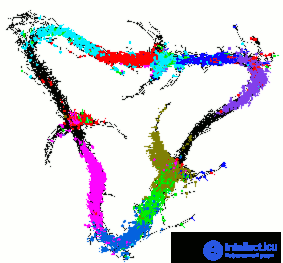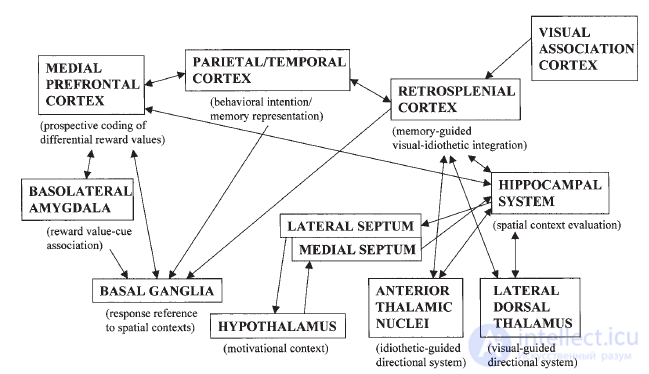
Fig. 1
Well, the truths are over. Now go to the controversial things.
I will not describe how important memory is for any information processing system. However, with human memory all very difficult. In principle, we found out that there are signals that travel through neurons, excitatory and inhibitory synapses that control the passage of signals, there are neuromodulators that change the susceptibility of synapses to signals, but how does it all work together, which results in a meaningful cognitive activity? Far from the fact that if you assemble such a system with millions of neurons, it will work adequately, and not like, say, an epileptic.
This gives reason to speculate about alternative theories of consciousness, in which they take some little-studied effect and declare it a panacea. One of these theories was put forward by R. Penrose and S. Hameroff - the quantum theory of consciousness, based on the theoretical background to the quantum interaction of tubulin microtubules that make up the cytoskeleton of neurons. If there are willing, I can discuss this theory in a separate chapter, but for now let us return to more proven theories.
So, before you take on a person with his hundreds of billions of neurons, it would be nice to see what is happening in more simple cases. And in the simplest case, when the memory effect can be defined as “a change in the reaction to repetitive stimulation”, it can be observed in the nervous system of C. elegans, which has 302 neurons and 5000 synapses. Despite this rudimentary nervous system, C. elegans developed the ability to sense temperature with an accuracy of 0.1 ° C and can learn to associate it with the amount of available food, thereby giving us the opportunity to argue that the mechanisms of associative memory can work with a small number of neurons. The simplicity of the neural system, in turn, helped the scientists to study in detail the mechanisms responsible for the ability to associate. In this case, it was found that the amount of produced calcium-binding protein Ce-NCS-1 is directly proportional to the ability to learn. Moreover, this protein is produced both in neurons directly sensing temperature, and in signal-carrying neurons (intercalary, intermediate neuron, interneuron), and directly affects the properties of synapses between them. Inserted neurons already collect and integrate information from temperature and olfactory neurons. The interesting thing here is that this protein belongs to the group of calcium-sensitive proteins that can be found everywhere, from yeast to people [1].
More complex mechanisms, such as the formation of conditioned and unconditioned reflexes, are studied, for example, on flies of fruit flies, mainly by turning off certain genes. For example, flies with dopamine and serotonin expression turned off were reluctant to absorb new associative information. If the expression was simply reduced, then the degree of learning depended on the number of these neurotransmitters. At the same time, it is important to note that if such flies were able to be taught something, they would not forget it. It turns out that these neutrotransmitters are responsible for learning rather than memory.
An important aspect is that the fruit flies already have a division into short-term and long-term memory, for which different areas of the brain are responsible. In particular, it is possible to grow flies, which will completely remember the association rules in just a few seconds. The separation into short-term and long-term memory comes from the dynamic nature of the work of neurons (they also communicate with spike patterns), the need to maintain a certain activity for a certain period of time (so that information from different parts of the brain can integrate) and the need to store the resulting experience is hardly stored in the form of spike patterns). For the theory of (artificial) intelligence, such a separation, generally speaking, is not necessary: if we already know how to present and process information, then how to store it on a computer we already imagine. Plus, I have not yet met any studies showing the processing of knowledge in long-term memory without attracting short-term (although processing itself takes place, for example, in cases when we recall something from the past. Then, by the way, long-term memory, generally speaking, overwritten again, and therefore, if you often remember something, over time it becomes difficult to separate reality from speculation).
Therefore, further I will mainly talk about short-term memory. It, in turn, can be divided into “immediate” (immediate memory), which has a large volume, but covers a time range from fractions of a second to several seconds, and working (working memory) - covering from several seconds to several minutes. Studies on monkeys have shown that stimulus information can be maintained by the constant activation of neurons for several seconds after the stimulus itself disappears, and there are neural network models that successfully model such processes [2]. The general rule of information storage can be described as follows: the longer the memory, the less detailed information about the stimulus and more abstract and conceptualized information is stored in it. The mechanisms of instant memory are provided directly in those areas of the cerebral cortex, where the processing of sensory information [3,4] (which we discussed in the previous chapter), but the working memory, as more global, includes mechanisms of not only the cerebral cortex (neocortex), but also its
wood of internal structures, such as the hippocampus (through which, by the way, is the consolidation of short-term memory into long-term memory).
What molecular mechanisms can be involved in the implementation of short-term memory? Short-term synaptic plasticity manifests itself as a weakening or amplification of the next signal after the previous one. Usually, if 2 signals arrive quickly (<20 ms), then the second is weakened due to a local decrease in the number of bubbles with a neurotransmitter or the deactivation of potential-dependent proteins. If between two signals passes 20-500 ms, then the second signal often produces a greater effect. In the case of weak synapses, a single signal may not be enough to depolarize the post-synaptic membrane, and the second signal, as it were, will use the released neurotransmitters from the first as a launching pad, increasing the likelihood of successful signal transmission. Longer effects are also observed, such as strengthening (facilitation) of the synaptic connection (divided into fast-acting - about 10 ms and long - hundreds of ms), post-convulsive potentiation (post-tetanic potentiation) - up to several minutes, as well as weakening ( depression), associated with both the depletion of neurotransmitters, and the impact of the accumulating number of neurotransmitters within the synapse (homosynaptic) and / or coming from the neighboring synapses (heterosynaptic). Together, these processes may be responsible for localizing excitation patterns in a certain area: some do not allow patterns to crawl along the neural network, while others do not support the activity of the pattern.

Fig. 2. Activation of neurons in place depending on the position in the maze (the activity of different neurons is shown in different colors).
The importance of the possibility of localizing excitation patterns can already be assessed in the previous chapter of Fig. 6. It is interesting that in the hippocampus (and not only) of rats (and not only), a structure not directly associated with the visual cortex, it is possible to identify such highly specialized cells that are activated if the rat is already visually familiar with the place [5] (Fig. 2 ). Moreover, their activity depends little on, for example, the lighting of the area, i.e. they are more likely associated with the current presentation of the rat about the place of stay, rather than with direct observation thereof. Such cells are called “place cells” - place cells. So in such cells excitement is maintained for the entire time while the rat is in the appropriate place. And since such a behavior of cells was observed not only in the hippocampus, theories are being advanced that such spatial information serves as a common “label” for the coordinated interaction of various brain structures in order to enable adaptive behavior to be organized.
I would also like to note that “all roads lead to the hippocampus,” and, despite the fact that not all types of memory are tied to the hippocampus (for example, with a damaged hippocampus, you can learn to play musical instruments), so in the integration of current visual information and relevant information in the working memory.

Fig. 3. The interaction of various brain structures to coordinate movement.
Somehow like this.
Hence the principles laid down in artificial intellectual systems: associativity and content-addressability for memory models, as well as learning opportunities, classification, planning, methods for solving other problems. Many questions remain about the presentation of data. Jeff Hokkins, who in particular invented the company Palm and its handhelds, proposes to simulate memory and the presentation of information in it using a hierarchical-temporal model (hierarchy temporal model), which has already been described here and which follows directly from the structure of the neocortex. Although for all undoubtedly interesting ideas, no one has yet managed to make a strong AI. So the truth is somewhere nearby.
[1] - Elements of Molecular Neurobiology, 3d ed., C. Smith, 2002
[2] - A Spiking Network Model of Short-Term Active Memory, D. Zipser et al., The Journal of Neuroscience, 1993, 13 (8), 3406-3420
[3] - Neuroscience, 3d ed., D. Purves, 2004
[4] - Representation and Brain, S. Funahashi, 2006, XII, 311-366.
[5] - A Neural Systems Analysis of Adaptive Navigation, S. Mizumori et al., Molecular Neurobiology, 2000, 21, 57-82



Comments
To leave a comment
Models and research methods
Terms: Models and research methods